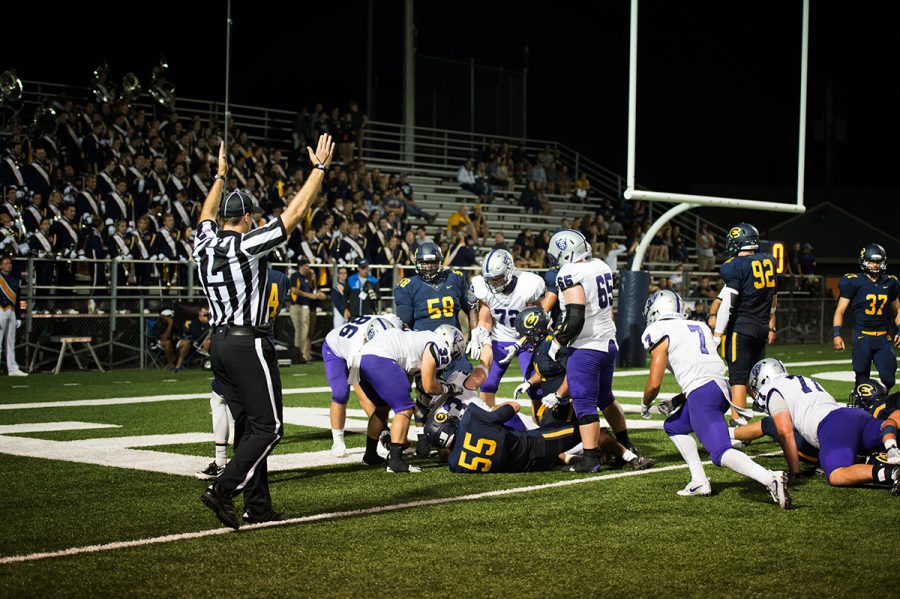Pay for play: It isn’t as simple as it seems
Why paying athletes at the Division III level may not be a possibility
More stories from Parker Reed
Photo by Kelsey Smith
Athletes work hard every single week but some colleges may not be able to pay them.
College athletes, no matter the level, work intensely every week to perform on the field and in the classroom. With these responsibilities, the possibility of working on the side is not an option for a lot of student athletes. So the natural thought is college athletes should be paid.
Makes sense right? Every week, teams sell tickets, merchandise and concessions, so there must be enough money to offer pay to athletes, right? No, that may not be accurate.
The fact that Division I athletes (especially in the major sports such as football and basketball) aren’t paid, is absolutely ludicrous. It is highway robbery. The athletes at this level generate millions upon millions of dollars every year for their school. The schools negotiate expensive network television contracts and expensive tickets and merchandise.
A great example of how these Division I schools are making money off of individual players, not just the team’s overall success, lies within the merchandise aisle.
If a particular college football player is doing well, the team is not allowed to sell merchandise with his name or likeness on it. But they are allowed to sell merchandise with his number on it and claim it is just promoting the team in general.
In reality they are just skating the line of what is acceptable and trying to market the player as a superstar, as the NFL does (legally, I might add).
At the Division I level, paying athletes makes perfect sense. They are the variable in the equation that generates all the income. If they aren’t successful, they will generate less income and the program will suffer.
They should be compensated for this, because they are almost acting as employees of the university.
That is true of Division I athletes but things are a lot different in the athletic departments of Division III schools.
Division III athletics generates far less revenue than Division I athletics does. They have much smaller stadiums (many more than 90 percent smaller), they do not have lavish television contracts and they sell far less merchandise and concessions at their games. That all adds up to far less money.
And for the sports outside of the four major ones (football, basketball, baseball and hockey) there is almost no money on the back end to pay athletes with. There is almost not enough money to even pay the coaching staff.
Paying athletes, when the situation is as dire as this, does not make economic sense for the university. But that does not detract from the struggle that many college athletes experience financially week in and week out.
Not being able to work forces student athletes to rely on summer earnings and the generosity of their parents for income to pay for textbooks and overpriced cafeteria food.
At least at the Division III level, one of two things needs to be done.
The first is improve the financial situation of student athletes by having reduced season lengths and practice times. This increased free time would allow them to work more to afford their tuition and food (and Netflix subscriptions, I mean, let’s be real).
But most athletic departments might be wary of doing this, as it gives them less time and opportunities to earn income for the university.
After talking with many high-up individuals in the UW-Eau Claire football program, it is apparent that scholarships for athletes are a thing of the past. They don’t make financial sense for the university.
The second way for the university to help these student athletes is to offer reduced priced meal plans or even provide meal’s after practices or games.
By offering some sort of subsidized food option, student athletes could benefit financially. With many partnerships with food suppliers, universities could find a cost effective way to implement this in the athletic department.
Division III universities may be skeptical of doing this while dealing with the increased budget cuts that are being implemented at universities all around the United States.
Paying student athletes at the Division I level makes perfect sense. They generate millions of dollars for their universities and deserve the right to take in some of that income for themselves. But paying student athletes at the Division III level does not make financial sense. They do not generate nearly enough money to be considered “highly profitable.” Taking a good chunk of money off at the back end to pay these athletes would put the schools’ athletic departments, and the university in general, in a worse place financially.
The solution is simply offer reduced food costs, or even free food to hard working student athletes. Making these already hard working student athletes clamber for food and petty income on the side is almost inhumane. Division III universities need to help out these student athletes and if they don’t, they need to accept the fact that the athletic department will continue to suffer because of it.

